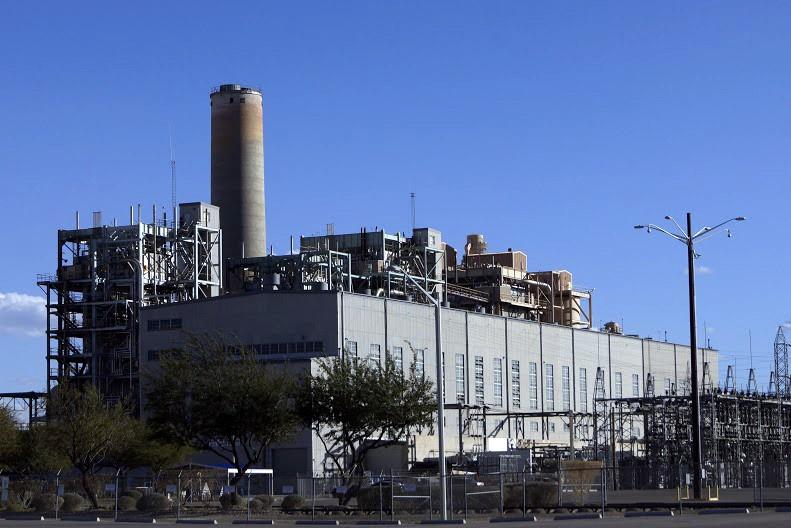According to the Intergovernmental Panel on Climate Change, human-caused carbon dioxide emissions will have to reach “net-zero” by 2050 in order to stay below a warming of 1.5 degrees Celsius since preindustrial levels. Not only would global warming above 1.5 degrees Celsius endanger the world’s coasts, existing ice sheets and coral reefs, but it is also projected that it could have hugely detrimental effects right here in Arizona.
The electricity sector has long contributed to rapid carbon dioxide emissions, most of the time because of the burning of coal, the item with the most responsibility for anthropogenic climate change. Tucson Electric Power, the local electric utility here in Tucson, has a history of predominantly using coal to generate electricity. Soon though, this will change.
TEP has produced a plan to move away from coal-powered electricity. Within the next twelve years, the utility looks to retire their remaining coal-burning power plants. According to Joseph Barrios, TEP’s supervisor of media relations and regulatory communications, 70% of electricity will be coming from solar and wind energy by 2035. These steps will result in an 80% reduction in carbon emissions.
RELATED: Dendrochronologists predict less of a potential for trees to fight climate change
Barrios said that the Navajo Generating Station near Page, Ariz., has already ceased coal-power energy production. There are also plans in place to shut down coal-power facilities at the San Juan Generating Station in New Mexico as well as TEP’s facilities in Springerville. The Springerville units are TEP’s largest coal-power generators, according to Barrios.
As TEP continues to retire facilities, more solar and wind resources will be continuously introduced. According to the TEP sustainable energy webpage, they look to “more than double its community-scale clean energy resources by next year.”
“We’ll have two large wind systems and a large solar array that should be up and running within a year,” Barrios said.
Barrios explained that now is the prime time for TEP to hop on renewable energy. Not only is managing renewable energy less expensive than it has been previously but it is also more reliable than ever before.
“Over time, the technology has become more affordable and it’s become more reliable,” Barrios said. “We’re simply arriving at a place where it makes just as much sense from an affordability standpoint as it would any other resource — they’re reliable, they’re predictable and of course obviously, they have vast environmental benefits.”
A wide variety of players took part in influencing this plan including environmental groups like the Sierra Club, Western Resource Advocates and other entities like Davis-Monthan Air Force Base and the Pima Council on Aging. TEP also integrated customers into the decision making process.
“We did get an earful and that’s great, that’s what we were looking for,” Barrios said. “We wanted to be more open with this process.”
One entity that played an extremely integral role in the development of TEP’s plans was the University of Arizona’s Institute of the Environment.
According to Andrea Gerlak, a professor in the School of Geography and Development, the UA was contracted to help introduce TEP to scientifically and geographically-informed options for greenhouse gas reduction goals.
To do this, there were two major phases. The first step was creating an analysis of what other utilities across the country are doing to set realistic emissions goals.
“In the end, we looked at maybe 30 utilities to see what kind of goals they were setting and why,” Gerlak explained.
In this step, the team made sure to take into account the different types of electric utilities they were examining. For example, coastal utilities that have greater access to water and hydropower resources already typically would have lower greenhouse gas emissions.
RELATED: New study finds love of affection heavily attributed to genetics in women
One aspect that the team found during this process was the importance of a midterm goal or “check-in dates.”
“When you’re setting a goal for 2035 or 2050, you have no idea about the new technologies or the new regulations that might come out so you’re kind of setting it a little bit blindly,” Gerlak said.
Gerlak said that they found that many utilities had implemented check-in dates, meaning that they would set a goal for a certain year but would set dates to revisit it in earlier years. Since TEP must produce an Integrated Resource Plan once a year, these “check-in dates” are built into their clean energy planning process.
The second phase was run by Will Holmgren, an assistant research professor of hydrology and atmospheric sciences, and Ben McMahan, a research scientist for the Institute of the Environment and an assistant professor in anthropology. This phase consisted of modeling work to help TEP understand what greenhouse gas emissions would result from a range of different energy-production portfolios.
Essentially, TEP had a list of portfolios for how to produce energy in the future. These portfolios highlighted how much natural gas, coal, solar power, wind power and other sources that TEP could use under different scenarios. Holmgren and McMahan’s job was to look at these different portfolios and produce analyses on the greenhouse gas emissions that they would result in.
“UA does this, not because it makes us money because we do this on top of our work,” Gerlak explained. “We do it because we want to help influence what happens in our community and because it’s learning for all of us.”
Gerlak described that in recent years, both Phoenix and Tucson have been hitting emissions limits. This has led to air pollution issues that Arizona has never had before. Thus, TEP’s new clean energy plan is a proactive response to a growing problem.
Follow Quinn McVeigh on Twitter









